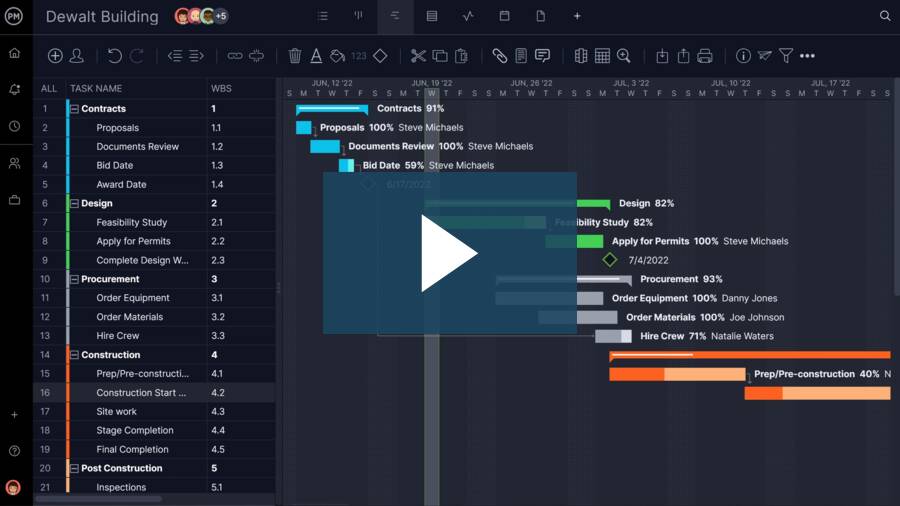Construction projects are notoriously difficult, and they’re known for encountering delays. They involve many moving parts, teams, equipment and materials, so your construction schedule should be thoroughly planned.
Tools that are embedded in construction project management software, such as Gantt charts and resource management, are key features to control the phases of a construction project. But they just facilitate the process. The construction schedule is the backbone of any successful project management for construction.
What Is Construction Scheduling?
Construction scheduling organizes activities and their sequence in a construction project. It’s a project management process that acts as a blueprint for how the project will be executed. It not only organizes the activities and tasks but the overall timeframe for the project, including milestones. The construction project manager will also track its progress to make sure that the project is on schedule.
Other items included in a construction schedule include deliverables, resource management, asset allocation, tasks, dependent tasks, task duration and deadline, as well as the budget and related costs of all that work. But the construction schedule isn’t etched in stone. Project managers will review and revise throughout the project.
Creating a construction schedule requires thorough planning and the right tools. ProjectManager is construction project management software that offers multiple project planning tools such as Gantt charts, kanban boards and project calendars so you can map out your project activities and create accurate construction schedules. ProjectManager also offers real-time dashboards, workload charts and timesheets so you can keep track of time and costs. Get started for free today.
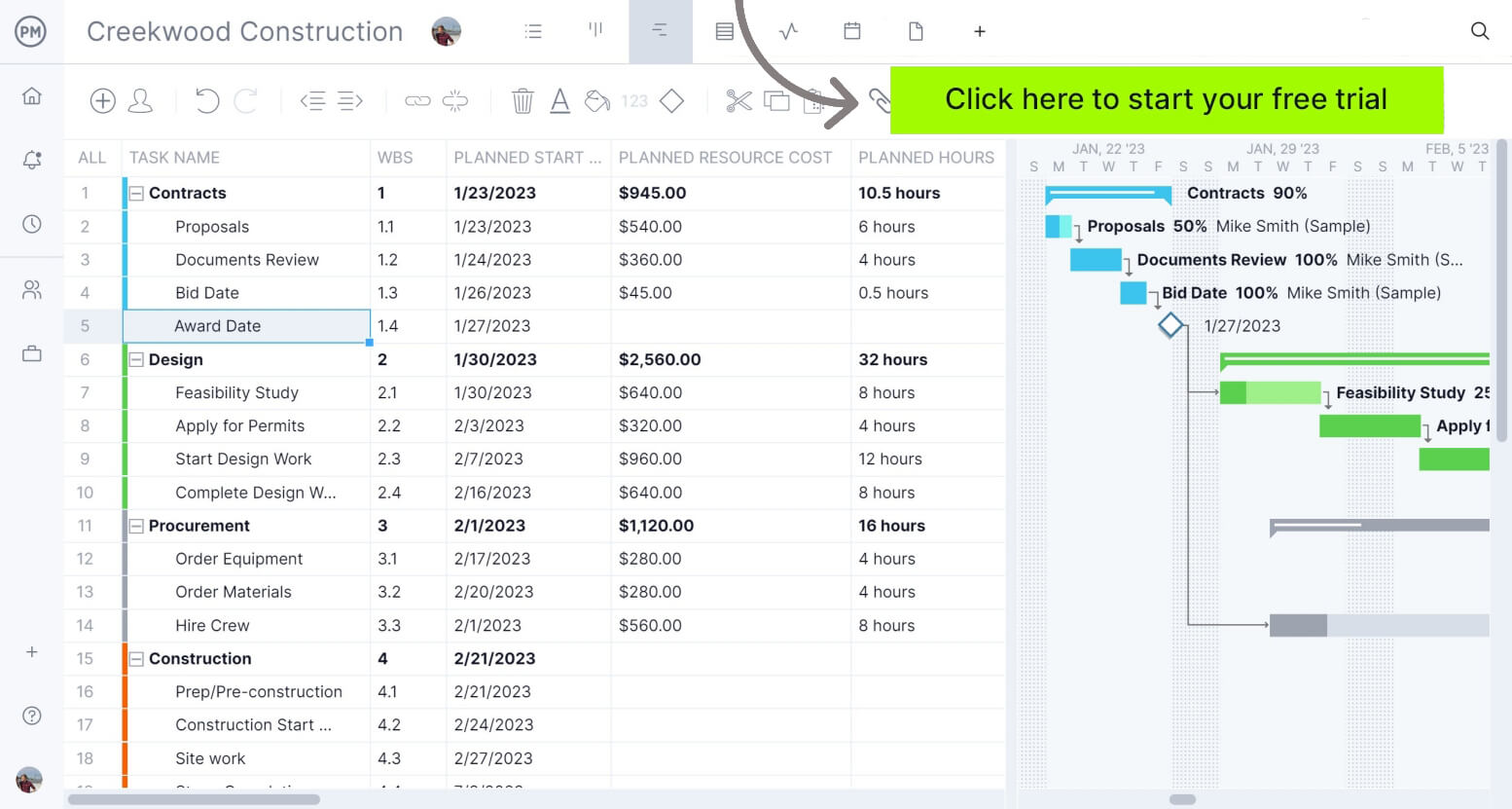
What Is a Construction Schedule?
A construction schedule is a timeline for every task and event in a construction project. The construction schedule is a fundamental part of the project planning phase, as it also defines the resources needed and the teams responsible for each task in the construction process.
Yes, construction scheduling is time-consuming. You want to take all the steps, avoid shortcuts and work toward creating the most accurate schedule you can. The more time you put into the construction schedule, the fewer issues you’ll have when you execute the project plan, which is key to good construction project management.
Why Is Construction Scheduling Important?
Think of construction scheduling as a way to catch problems before they derail the project. Construction professionals rely on construction schedules to manage resources more effectively, coordinate efforts with subcontractors, manage risks, ensure quality and set client expectations.
Construction project managers will use the construction schedule to keep the project on track, within budget and up to the agreed-upon standard. As every task is defined and outlined, it’s clear to see the needed resources and how they’re divided between team members throughout each stage of development.
What Should Be Included In a Construction Schedule?
Construction schedules are made up of various parts. The next time you’re putting one together, consider including the following sections.
- Project Tasks: A detailed list of all tasks and activities included in each project phase
- Project Milestones: Key deadlines or noteworthy points in the project that notate the completion of major deliverables
- Task Dependencies: Shows the relationships between tasks as some must be finished before others can start
- Project Resources: These include labor, materials and equipment needed to complete the project
- Key Deliverables: Specific, measurable outcomes such as a final product, milestones, design documents, reports, compliance documents and project closure documents
- Work Packages: A work package is a detailed subset of the project including a specific set of tasks or activities to complete
- Project Timeline: Of course, be sure to include the project timeline complete with the project phases, including a target completion date
Since each construction project is unique, the specific parts of a construction schedule may change based on company and stakeholder needs.

Get your free
Construction Schedule Template
Use this free Construction Schedule Template to manage your projects better.
Get the template
Construction Schedule vs. Schedule of Works
A construction schedule and a schedule of works share things in common, but they’re different project documents. A schedule of works is a contract, a construction project schedule is not. The schedule of works lists the work that must be completed on a construction project, but a construction schedule is far more than just a list of work.
A schedule of works doesn’t have the detail and scope of a construction schedule, which includes the duration and deadline for the work, resources needed to execute those tasks and associated costs. Construction schedules also have milestones, identify dependent tasks and more.
5 Steps to Make a Construction Schedule
If you follow these five steps, you’ll hit the major points that need addressing when creating a construction project schedule.
1. Get Info and Tools
Construction scheduling involves different types of resources, stakeholders and participants. Begin by listing all subcontractors involved in the job as there are always many in a construction project. Once you have the list, reach out to them and ask how much time it’ll take to procure materials. Then, ask how long their part of the project is estimated to take. This is key for sound time estimation on your part.
You’ll also need to speak with the local code office and get a list of requirements and what inspections will be needed throughout the build. Code restrictions vary depending on the type of construction and materials you’ll be using, so you’ll need to research to make sure your project is compliant.
When it comes to budgeting your project, you’ll need to go through the process with your bank and determine when they’ll release funds. You’ll need a steady influx of cash to keep the project moving forward, so before it starts, it’s key to have an understanding of your bank and its process of disbursing money. Talking to the bank before scheduling gives them a big-picture view of the project and valuable insight into how to schedule.
Determine a project management tool that’ll suit your needs. Some templates can help you get started with your construction schedule if you don’t want to build your plan and schedule from scratch. Naturally, ProjectManager being an online project management software recommends an online tool. But we’ll get to those benefits in full later.
Related: 18 Best Construction Scheduling Software
2. Collect and Prioritize Tasks within the Construction Schedule
You have context and tools, but now you need to break the project down into the steps that will lead it from a construction plan to a completed project. These are the tasks. You can’t have an accurate construction schedule until you have a thorough listing of every task that must take place to end with a successful construction.
You can use a work breakdown structure (WBS) to get a handle on the size and scope of your project. You can think of this tool as a way to visualize your deliverables by starting with whatever you’re going to construct and then breaking it down level by level until you’re at the most basic parts.
At this point, it doesn’t hurt to gather the team and your subcontractors to pick their brains. Remember, the more thorough your task list, the more accurate your construction schedule. Tasks are what can derail a project, so keep your mind on the scope. And don’t forget that some tasks are dependent on others, so you’ll want to link those.
Once you have your task list as complete as possible, you’ll next need to put those tasks in order. The WBS can help with this, as it takes a complex project and boils it down to the essential parts and when they need to be worked on. You can use Gantt chart software to spread these tasks over a project timeline. We’ll get into more detail on that in a bit.
Small tasks help to break up the project into larger phases or milestones. A milestone is a point in the project that marks the end of some large phase, say cementing the foundation or adding electrical. Accurately assessing the different tasks and milestones that make up your project is critical for effective construction scheduling.
3. Add Duration to Tasks
Now take each of the tasks and give them a start and finish date, which creates a bar chart on the Gantt chart that represents the duration of the task. These determinations must be realistic. A construction schedule is impacted by climate and weather forecasts are only so accurate, especially long-term. Look at historical data about the weather to get an estimation of how the climate might impact the work.
Depending on how long-term the project is, you’ll need to calculate your construction schedule holidays and consider sick and vacation days for employees. If other seasonally related or personal issues might come up, be sure to use them as a ruler when measuring your schedule’s duration.
Outside of those issues, there’s working with subcontractors and suppliers. The specifics are outlined in your contract, but more often than not those dates are subject to change. Your construction schedule should have the wiggle room to accommodate fluctuations.

It’s important to make the schedule realistic. You might want it done at a certain date, but to achieve that goal, you might be tempted to cut corners and sacrifice quality. This isn’t possible in construction. The repercussions are too serious. So, be honest with yourself and give everything enough time in your construction schedule to be completed correctly.
Don’t neglect non-task-related scheduling, such as procurement, delivery and other sources that are crucial to the project. You need to have a clear picture of what to order or reorder supplies. It’s as important as the build. So is scheduling in any inspections, so there’s time in your schedule to respond to any code issues.
There’s also the financial portion of the project to keep in mind when scheduling. Add the bank draws and link them to the appropriate tasks in your construction schedule. You and the bank need to know when money will be required. The last thing you want is to chase the cash and stall the project.
4. Allocate and Execute Resources Across Your Construction Project
In a nutshell, construction scheduling is about activities and resources. Tasks won’t get done by themselves, of course, but allocating that work to teams can get confusing in your construction schedule with so many subcontractors to oversee. By color-coding tasks, you can easily distinguish the different teams and work. Now you can pinpoint who’s working on what once the project execution phase begins.
You should’ve already made estimations on the length of work from your teams and have a detailed profile of their skills and experience to assign them appropriately. After allocating your resources, a project management tool like ProjectManager can send alerts when new tasks are assigned and deadlines are due.
Once you have the people assigned to the work, the construction schedule is ready to venture into the real world. Make sure that your resources are balanced. You don’t want to over-allocate one team while another is twiddling its thumbs. ProjectManager has workload calendars to help with this process.
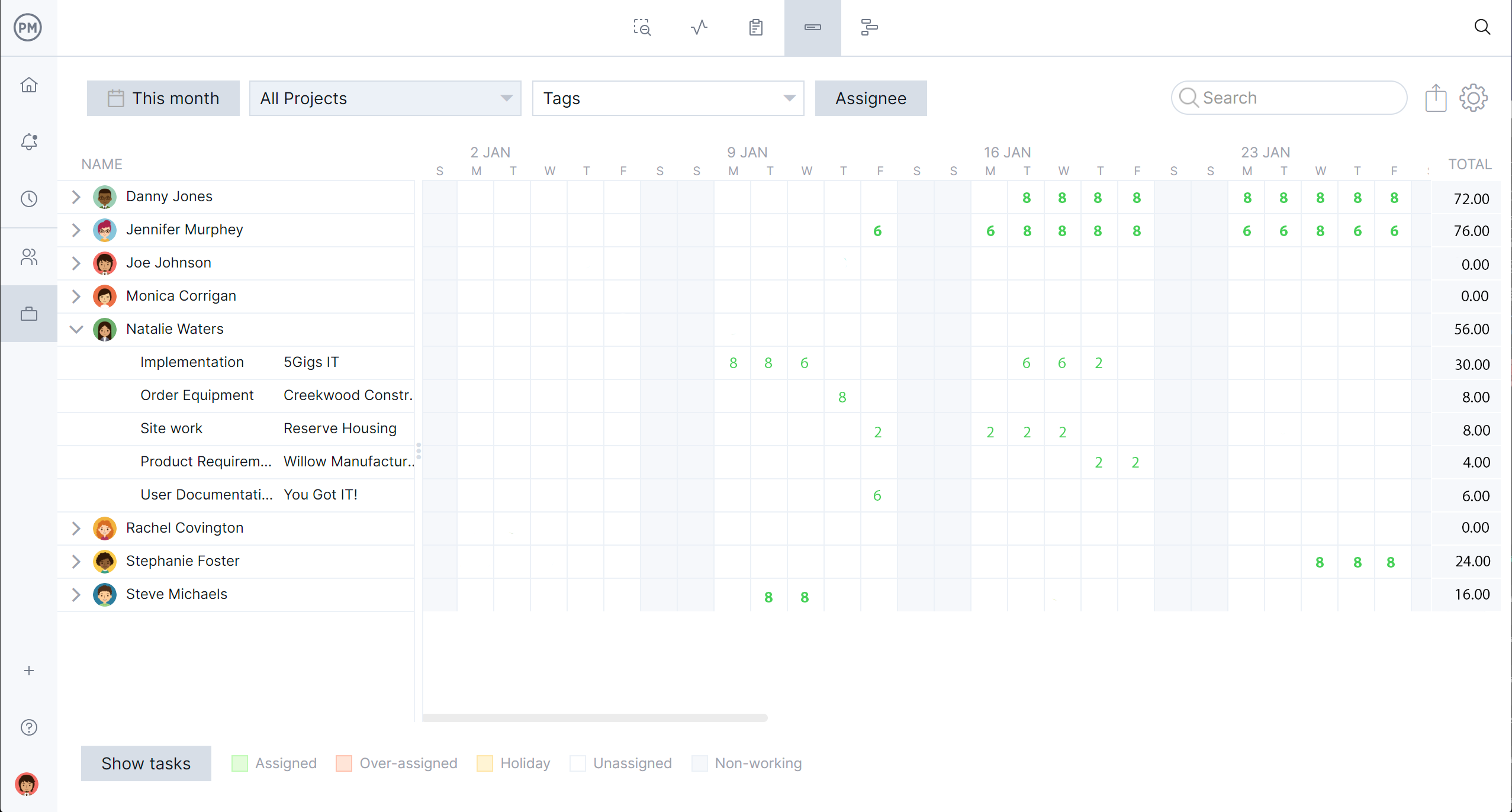
5. Review, Review, Review
Construction scheduling is highly complex and requires permanent monitoring. No construction schedule is written in stone, at least none that will succeed. Things change, and if you’re not monitoring and reviewing throughout the project, those changes will send you off track—or worse.
You’ll need to look over the construction schedule throughout all project phases to make sure your actual progress aligns with your plan. Look at your schedule daily and depending on your time, update frequently. You can use our construction daily report template to keep track of the progress of your construction project.
This is a matter of time management. If you find that a daily update takes you away from other project issues and responsibilities, then maybe you need to set aside time each week to respond to the changes you’ve noted daily and apply them to the schedule. Monitoring and adjusting your construction schedule as on- and off-site issues arise is perhaps the most important aspect of keeping your project on schedule.
Construction Schedule Example
One of the easiest ways to understand the impact of a construction schedule is with an example. Let’s imagine a construction company was contracted to create a new office building.
Below, you can see the construction schedule made on ProjectManager’s Gantt chart. The project is broken down into various phases including design and planning, permits, site preparation, foundation, etc. On the left-hand side is a timeline with the task data that are visually represented on the right-hand side.

Each phase is made up of specific tasks with a planned start and planned finish date for the team to reference as they execute their work. Project milestones are included as well, which mark the end of a piece of work, task sequence or project management phase. In the construction schedule example above, foundation inspection is an example of a milestone.
The “how” and “why” in this example provide context for the project manager to reference throughout the project. If changes need to be made, such as moving the planned finish date for zoning approvals, the project manager can do so directly on the schedule.
Construction Scheduling Techniques
Construction scheduling techniques help a project run smoothly by outlining a series of steps or activities to complete in a specific order. They also identify how, where and what is used to capture and manage those processes. We’ve outlined some popular techniques below.
- Line of Balance (LOB): The line of balance construction scheduling technique plans and controls repetitive tasks and processes. It’s often used when there is a series of similar tasks in a repetitive sequence and ensures these tasks are executed efficiently and on schedule.
- Critical Path Method (CPM): The CPM technique identifies the sequence of tasks and the shortest possible duration to finish them. It outlines the tasks that are needed for project completion and helps project managers focus on them. If there is a delay to the critical path, it impacts the finish date.
- Program Evaluation and Review Technique (PERT): Another construction scheduling technique called PERT helps analyze the variability in task durations to provide a flexible yet realistic project schedule. It benefits projects where activity durations are uncertain and helps facilitate stakeholder communication.
Commonly Used Construction Scheduling Tools
Whether for a commercial or residential construction schedule, some tools can help plan, track and manage projects through every phase.
- Project Network Diagrams: A project network diagram visually represents the sequence of project tasks, highlighting both task dependencies and the overall workflow. Project managers can leverage this tool to help identify the critical path, outline the relationship between tasks and better manage the project schedule.
- Gantt Charts: A mainstay in project management, Gantt charts are the quintessential construction scheduling tool that showcases a task’s start and end dates, duration and dependencies. They provide a clear and chronological overview to ensure projects are completed within the expected budget and timeframe.
- Milestone Charts: Milestone charts are another visual construction scheduling tool to highlight key events and project achievements. Significant milestones are displayed on a timeline with a focus on essential deliverables, deadlines and critical achievements. With this tool, the focus is on tracking overall progress instead of task durations.
Construction Schedule Template
If you’re looking for help in creating a construction schedule, check out our free construction schedule template. When you open this template in ProjectManager, you’ll be able to organize your schedule on powerful construction Gantt charts that link all four dependencies, list deliverables, manage resources, identify milestones and costs and even filter for the critical path.
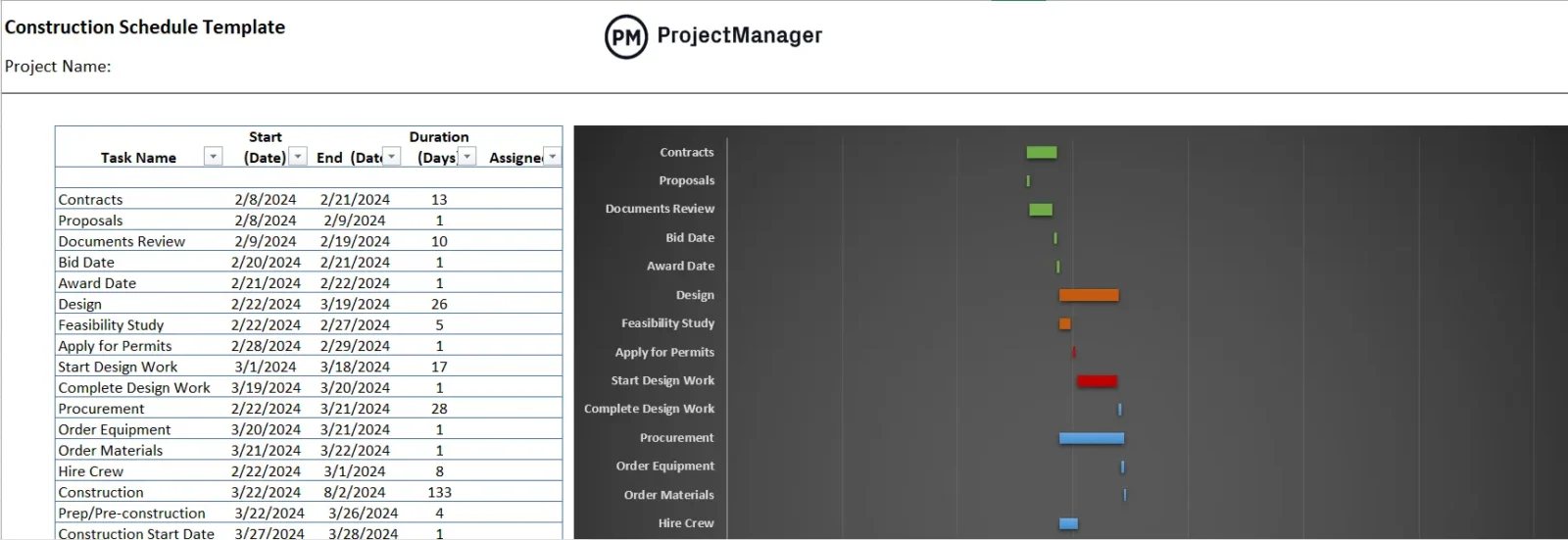
More Construction Project Management Templates
The construction schedule template is one of the dozens of free construction templates for Excel and Word that you can download on our site. We have free templates for every phase of your project and many industries as well. Here are a few for construction.
Construction Daily Report Template
At the end of every day, construction workers have to document what work was performed, whether it was done or delayed, weather conditions on site and much more. Our free construction daily report for Excel outlines everything you need to cover so you can fill in the blanks.
Construction Estimate Template
Being able to forecast an accurate estimate for construction costs is key to managing the project. Our free construction estimate template for Excel helps you figure out the direct indirect, labor and material costs of your project.
Bill of Quantities Template
A bill of quantities lists all the materials and labor required for a construction project. If you’re managing a larger construction project, you’ll need our free bill of quantities template for Excel. It’s a crucial document for the bidding process as well as helping make a more accurate estimate of the project’s costs.
How to Create a Construction Schedule With ProjectManager
We’ve been hinting about how ProjectManager and construction scheduling go hand in glove, so let’s take a moment to go into greater detail about the many features available in our software that can assist you when scheduling your construction project.
Gantt Charts for Plans and Schedules
Beyond templates to get you started, we have an online Gantt chart that helps you plan your construction schedule. You can import your task list and it instantly populates the timeline. Then add the duration of each task and a bar chart marks the start to end dates. If any tasks are dependent, they can be easily linked. You can also set milestones across the timeline.
You can then assign directly from the construction Gantt chart. Any relevant schematics or notes can be added directly to the task where team members can collaborate. They can add as many construction documents as they want with our unlimited file storage and comment on any issues with other team members by simply tagging them.
When a change in your construction schedule occurs, adjusting the Gantt chart is simple. Just drag and drop the start and end dates. There are automated notifications, so team members are alerted of any changes to keep everyone on the same page.
Resource and Team Management
When it comes to tracking time and money throughout your construction project, we have you covered with resource management software. Managing your resources can be complicated in a construction project, but our online software gives you real-time data to better meet that goal.
You can categorize teams, supplies, equipment, etc., adding hourly rates that’ll reflect across our software. When those hours are logged, the actual cost is automatically compared to the planned cost. This gives you the tools to manage construction costs.
Teams can be managed, too. Our software details working days, holidays and planned hours over the course of the project, whether they’re on-site or even in different time zones. You can block out vacations and holidays, keeping your project schedule on track. With our workload feature, you can easily see who’s assigned to what. The workload is color-coded, so you can catch any imbalances quickly and reassign from the workload page. Filter by project, team or both and get the data you want. These features are essential for creating and managing your construction schedule.
Timesheets are designed to automatically update when employees finish their assigned tasks. You can track their logged hours on our real-time dashboard, which also monitors task progress and more.
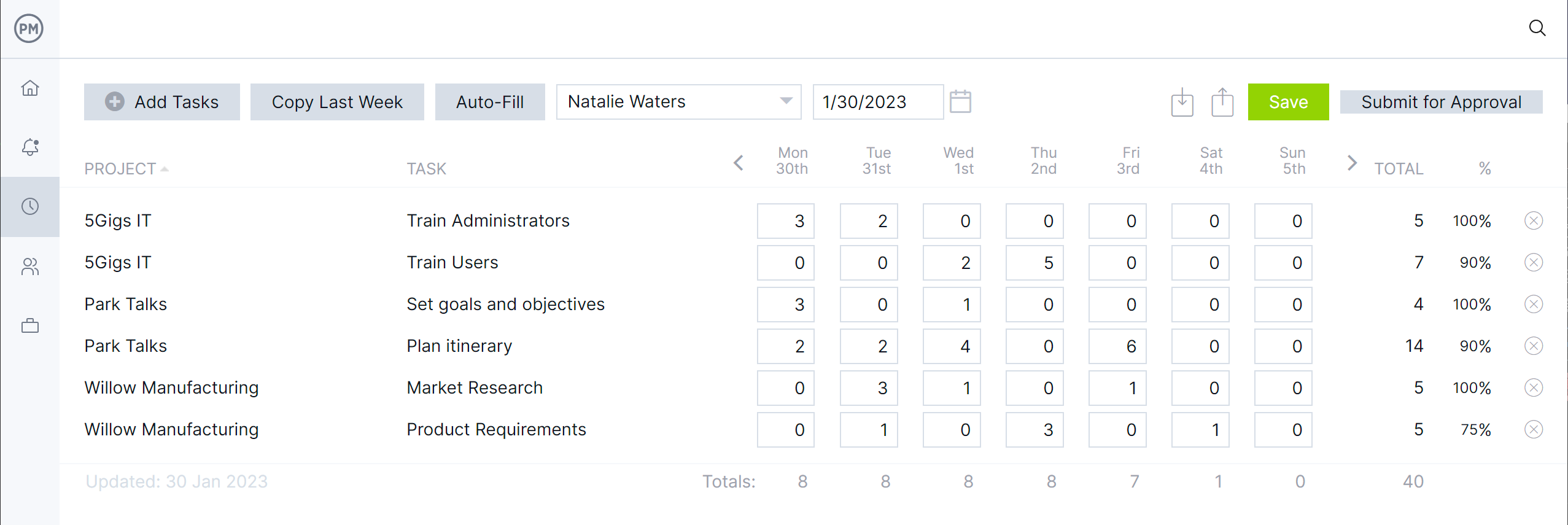
That’s not all; there’s in-depth reporting on project workload, availability, timesheets and more. Reports can be filtered to show just what you need to know or offer a more broad overview when presenting to clients and other stakeholders. ProjectManager keeps your construction schedule on track.
Related Construction Scheduling Content
- Construction Project Management Software
- Best Construction Scheduling Software Rankings
- Best Construction Estimating Software Rankings
- How to Make a Material Schedule for Construction
- Fragnet Schedule in Construction: Use Cases and How-to Guide
- ¿Cómo Hacer un Cronograma de Obra? Una Guía Rápida
- Comment créer un calendrier de construction : guide rapide
- Bauzeitplan erstellen: Bauzeitplanung einfach erklärt
ProjectManager is online project management software with the tools you need for construction scheduling. Our features make planning, monitoring and reporting on your project more efficient and effective. Being online means our software is accessible everywhere and at any time. Plus, the data you get is more accurate because it’s updated immediately. Try ProjectManager for free with this 30-day trial offer.

